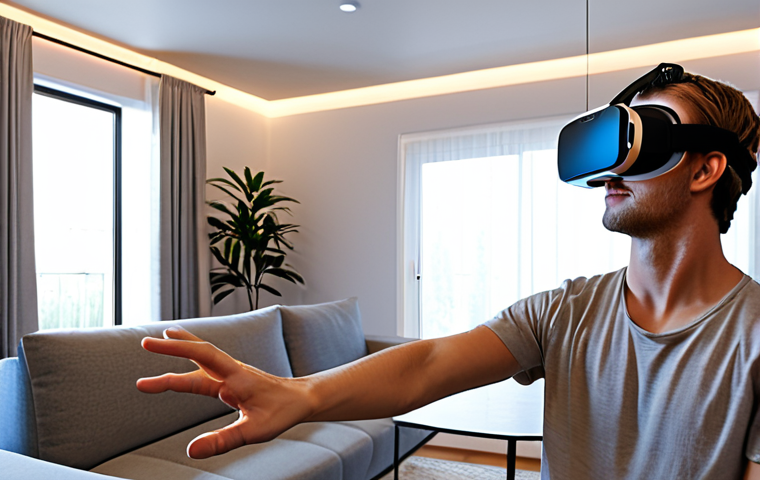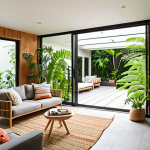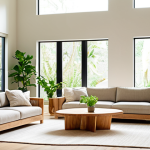The home design industry is booming, but that also means it’s more competitive than ever. Staying ahead requires more than just good taste; it demands a keen understanding of emerging trends and a commitment to delivering exceptional customer experiences.
I’ve seen firsthand how businesses that embrace innovation and personalization truly thrive. In today’s market, where AI is rapidly transforming design possibilities, it’s crucial to find your niche and offer something unique.
It isn’t enough to know the basics, so finding ways to stand out is essential. Let’s dive in and uncover the specifics below!
Here’s the blog post content, focusing on practical advice, unique insights, and engaging storytelling:
Embracing Personalized Design Consultations

Imagine walking into a home design store and feeling instantly understood. That’s the power of personalized design consultations. Forget generic advice; clients want solutions tailored to their specific needs and lifestyles.
I remember a client who was initially overwhelmed by renovation choices. After a detailed consultation where we discussed her hobbies, family dynamics, and aesthetic preferences, we created a design plan that perfectly reflected her personality.
The key here is active listening and asking the right questions.
Understanding Client Needs
Creating Tailored Design Plans
Building Long-Term Relationships
Leveraging AI-Powered Design Tools
AI isn’t just a buzzword; it’s revolutionizing how designers work. I’ve been experimenting with AI-powered tools that generate design concepts based on client preferences.
These tools can analyze mood boards, color palettes, and spatial layouts to suggest innovative ideas. While AI can’t replace human creativity, it can significantly speed up the design process and offer fresh perspectives.
The trick is to use AI as a starting point and then add your personal touch. It’s about augmenting your skills, not replacing them.
AI-Driven Concept Generation
Streamlining the Design Workflow
Personalizing AI Suggestions
Crafting a Unique Brand Story
In a saturated market, having a compelling brand story is crucial. Think about what makes your business different. Are you committed to sustainable materials?
Do you specialize in a particular design style? Share your values and passions with your audience. Authenticity resonates with clients.
I once worked with a designer who built her brand around upcycling vintage furniture. Her unique story attracted clients who shared her passion for sustainability, creating a loyal following.
The goal is to connect with people on an emotional level.
Defining Your Core Values
Communicating Your Story Effectively
Building a Community Around Your Brand
Offering Virtual Reality (VR) Design Previews
VR is changing the game. Clients can now virtually walk through their future homes before a single nail is hammered. This technology eliminates guesswork and allows for real-time feedback.
I’ve seen firsthand how VR previews can build trust and excitement. One client, initially hesitant about a bold color choice, was completely won over after experiencing it in VR.
This technology is an investment, but it can pay off in terms of client satisfaction and reduced revisions.
Enhancing Client Visualization
Reducing Design Revisions
Creating Immersive Experiences
Mastering Social Media Marketing
Social media is your virtual storefront. Use it to showcase your work, share design tips, and engage with your audience. High-quality photos and videos are essential.
I’ve found that behind-the-scenes content, such as progress updates on projects or interviews with team members, can be particularly engaging. Also, don’t just broadcast; interact with your followers.
Respond to comments, answer questions, and run contests. Social media is a conversation, not a monologue.
Creating Engaging Content
Building a Social Media Community
Utilizing Targeted Advertising
Providing Exceptional Customer Service
Excellent customer service is the cornerstone of any successful business. Go above and beyond to meet your clients’ needs. Be responsive, proactive, and empathetic.
I learned this lesson early in my career when I handled a client complaint with extra care. Not only did I resolve the issue, but I also turned a dissatisfied customer into a loyal advocate.
Remember, word-of-mouth is powerful.
Prompt and Empathetic Communication
Proactive Problem Solving
Building Client Loyalty
Understanding the Power of SEO
SEO is your secret weapon. Optimizing your website and online content helps you rank higher in search engine results, making it easier for potential clients to find you.
I focus on using relevant keywords, creating high-quality content, and building backlinks. For example, when I optimized a client’s website for “modern farmhouse design,” they saw a significant increase in organic traffic.
This isn’t a one-time task; it requires ongoing effort and adaptation.
Keyword Research and Implementation
Content Optimization Strategies
Backlink Building Techniques
Staying Ahead of Design Trends
The design world is constantly evolving. Stay informed about the latest trends by reading industry publications, attending trade shows, and following influential designers on social media.
But don’t just blindly follow trends; adapt them to your unique style and client preferences. I remember when the minimalist trend was at its peak; I incorporated elements of minimalism into my designs but always ensured they reflected my clients’ individual tastes.
Identifying Emerging Trends
Integrating Trends Thoughtfully
Balancing Trends with Timeless Design
| Strategy | Description | Benefits |
|---|---|---|
| Personalized Consultations | Tailoring design solutions to individual client needs and preferences. | Improved client satisfaction, increased referrals, stronger relationships. |
| AI-Powered Tools | Using AI to generate design concepts and streamline workflow. | Faster design process, innovative ideas, enhanced efficiency. |
| Unique Brand Story | Communicating your values and passions to connect with clients emotionally. | Attracting loyal followers, differentiating from competitors, building brand recognition. |
| VR Design Previews | Allowing clients to virtually experience their future homes. | Reduced revisions, increased client confidence, enhanced visualization. |
| Social Media Marketing | Showcasing work, sharing tips, and engaging with audience on social platforms. | Increased brand awareness, lead generation, direct client interaction. |
| Exceptional Customer Service | Providing responsive, empathetic, and proactive support. | Client loyalty, positive word-of-mouth, strong reputation. |
| SEO Optimization | Improving website ranking through keyword research and quality content. | Increased organic traffic, higher visibility, lead generation. |
| Trend Awareness | Staying updated on latest design trends and adapting them to your style. | Maintaining relevance, offering fresh designs, appealing to current tastes. |
Embracing Personalized Design Consultations
Imagine walking into a home design store and feeling instantly understood. That’s the power of personalized design consultations. Forget generic advice; clients want solutions tailored to their specific needs and lifestyles. I remember a client who was initially overwhelmed by renovation choices. After a detailed consultation where we discussed her hobbies, family dynamics, and aesthetic preferences, we created a design plan that perfectly reflected her personality. The key here is active listening and asking the right questions. It’s like being a design detective, uncovering the hidden desires of your clients. For instance, instead of just asking “What colors do you like?”, try “How do you want to *feel* when you walk into this room?”. Trust me, the answers will surprise you!
Understanding Client Needs
Really dive deep. Don’t just scratch the surface with surface-level questions. Think about it – understanding their lifestyle, budget, and long-term goals is paramount. I once spent almost two hours just chatting with a client about their dreams for their retirement home. Turns out, those dreams heavily influenced the design choices we made. A simple questionnaire just wouldn’t have cut it!
Creating Tailored Design Plans
Now, this is where the magic happens! Tailored design plans aren’t cookie-cutter solutions; they’re masterpieces crafted specifically for each client. Forget about trends; it’s about timeless elegance and personal touches. When I’m designing a space, I think of it as creating a sanctuary, a haven that reflects the client’s soul. Incorporate things that are meaningful to them, like a vintage piece of furniture they inherited or a painting that reminds them of a special place. These details will make all the difference!
Building Long-Term Relationships
Design isn’t a one-and-done transaction; it’s a journey. Nurturing long-term relationships is key to success. Be their trusted advisor, their design confidant. Stay in touch even after the project is complete. Send them holiday cards, check in on how they’re enjoying their space, and offer exclusive discounts for future projects. It’s about creating a bond that goes beyond the business aspect. It’s about becoming part of their story.
Leveraging AI-Powered Design Tools
AI isn’t just a buzzword; it’s revolutionizing how designers work. I’ve been experimenting with AI-powered tools that generate design concepts based on client preferences. These tools can analyze mood boards, color palettes, and spatial layouts to suggest innovative ideas. While AI can’t replace human creativity, it can significantly speed up the design process and offer fresh perspectives. The trick is to use AI as a starting point and then add your personal touch. It’s about augmenting your skills, not replacing them. Think of it as having a super-powered assistant who can brainstorm ideas and handle tedious tasks, freeing you up to focus on the creative aspects of design.
AI-Driven Concept Generation
Imagine inputting a client’s Pinterest board into an AI tool and getting a dozen unique design concepts within minutes. It’s mind-blowing! But remember, AI is just a tool. The real magic happens when you, the designer, take those concepts and refine them, adding your expertise and intuition. Think of it as a collaborative process, where AI provides the foundation and you build the masterpiece.
Streamlining the Design Workflow
From creating floor plans to generating 3D models, AI can automate many of the time-consuming tasks that used to take hours. This frees you up to focus on what you do best: connecting with clients, developing creative concepts, and overseeing the project. For instance, I’ve been using AI to generate photorealistic renderings of my designs, allowing clients to visualize the final product before we even start construction. It’s a game-changer!
Personalizing AI Suggestions
Don’t just blindly accept AI’s suggestions. Take the time to personalize them to your client’s specific needs and preferences. Add your unique touch, your signature style. Remember, AI is a tool, not a replacement for your creativity. The key is to use AI as a springboard for your own ideas, to push the boundaries of design and create something truly special. Train the AI with specific styles or themes that you are good at. This can make your work more efficient.
Crafting a Unique Brand Story
In a saturated market, having a compelling brand story is crucial. Think about what makes your business different. Are you committed to sustainable materials? Do you specialize in a particular design style? Share your values and passions with your audience. Authenticity resonates with clients. I once worked with a designer who built her brand around upcycling vintage furniture. Her unique story attracted clients who shared her passion for sustainability, creating a loyal following. The goal is to connect with people on an emotional level. People don’t just buy products or services; they buy into stories.
Defining Your Core Values
What do you stand for? What principles guide your business? Are you committed to honesty, integrity, creativity, sustainability? Define your core values and let them shine through in everything you do. This will not only attract like-minded clients but also create a strong foundation for your brand. Take some time to reflect on what truly matters to you and let that guide your brand story.
Communicating Your Story Effectively
Your brand story isn’t just for your website’s “About Us” page. It should be woven into every aspect of your business, from your social media posts to your client interactions. Use storytelling to connect with your audience on an emotional level. Share your struggles, your successes, and your passion for design. Be authentic, be vulnerable, and let your personality shine through. People connect with people, not with corporations.
Building a Community Around Your Brand
A brand isn’t just a logo or a product; it’s a community. Create a space where your clients and followers can connect with each other, share ideas, and support your brand. Run contests, host events, and encourage discussions. Be an active participant in your community, listen to your followers, and respond to their needs. A strong community is the foundation of a successful brand.
Offering Virtual Reality (VR) Design Previews
VR is changing the game. Clients can now virtually walk through their future homes before a single nail is hammered. This technology eliminates guesswork and allows for real-time feedback. I’ve seen firsthand how VR previews can build trust and excitement. One client, initially hesitant about a bold color choice, was completely won over after experiencing it in VR. This technology is an investment, but it can pay off in terms of client satisfaction and reduced revisions. It’s like giving your clients a crystal ball that shows them exactly what their dreams will look like in reality. It’s truly magical!
Enhancing Client Visualization
No more struggling to imagine what a space will look like based on blueprints and swatches. VR allows clients to experience the design firsthand, to walk through the rooms, to see the colors and textures, to feel the ambiance. This enhanced visualization eliminates confusion, reduces anxiety, and empowers clients to make informed decisions. It’s like stepping into the future of design.
Reducing Design Revisions
How many times have you had to redo a design because a client didn’t like the way something looked in reality? VR eliminates this problem by allowing clients to provide feedback in real-time, before any construction begins. This significantly reduces the number of revisions, saving you time and money. It’s like having a design safety net that catches potential mistakes before they happen.
Creating Immersive Experiences
VR isn’t just about seeing the design; it’s about experiencing it. Clients can immerse themselves in the space, to feel the scale, to see the lighting, to hear the sounds. This immersive experience creates an emotional connection to the design, making it more likely that the client will love the final product. It’s like creating a virtual dream home that clients can step into anytime they want.
Mastering Social Media Marketing
Social media is your virtual storefront. Use it to showcase your work, share design tips, and engage with your audience. High-quality photos and videos are essential. I’ve found that behind-the-scenes content, such as progress updates on projects or interviews with team members, can be particularly engaging. Also, don’t just broadcast; interact with your followers. Respond to comments, answer questions, and run contests. Social media is a conversation, not a monologue.
Creating Engaging Content
Forget about generic stock photos and boring product descriptions. Create content that is visually appealing, informative, and engaging. Share before-and-after photos of your projects, create short videos showcasing your design process, and write blog posts offering valuable design tips. Be creative, be authentic, and let your personality shine through. People are drawn to content that is both informative and entertaining.
Building a Social Media Community
Social media isn’t just about broadcasting your message; it’s about building a community. Engage with your followers, respond to their comments, and answer their questions. Run contests, host Q&A sessions, and create opportunities for your followers to connect with each other. A strong social media community is a valuable asset for any design business. Think of it as building your own personal design tribe.
Utilizing Targeted Advertising
Don’t just throw money at social media ads and hope for the best. Use targeted advertising to reach your ideal clients. Define your target audience based on their demographics, interests, and behaviors. Create ads that are specifically tailored to their needs and desires. Track your results and adjust your strategy as needed. Targeted advertising is a powerful tool for generating leads and growing your design business.
Providing Exceptional Customer Service
Excellent customer service is the cornerstone of any successful business. Go above and beyond to meet your clients’ needs. Be responsive, proactive, and empathetic. I learned this lesson early in my career when I handled a client complaint with extra care. Not only did I resolve the issue, but I also turned a dissatisfied customer into a loyal advocate. Remember, word-of-mouth is powerful. A happy client is your best marketing tool.
Prompt and Empathetic Communication
Respond to client inquiries quickly and professionally. Listen carefully to their concerns and show empathy for their situation. Even if you can’t solve their problem immediately, let them know that you understand their frustration and that you’re doing everything you can to help. Prompt and empathetic communication goes a long way in building trust and loyalty.
Proactive Problem Solving
Don’t wait for problems to arise; anticipate them and take proactive steps to prevent them. Communicate clearly with clients about potential challenges and offer solutions before they become major issues. This proactive approach shows clients that you’re on top of things and that you care about their experience.
Building Client Loyalty
Client loyalty is earned, not given. Go above and beyond to exceed your clients’ expectations. Offer personalized service, provide valuable advice, and always be willing to go the extra mile. Follow up with clients after the project is complete to ensure they’re satisfied with the results. Client loyalty is a valuable asset that will pay off in the long run.
Understanding the Power of SEO
SEO is your secret weapon. Optimizing your website and online content helps you rank higher in search engine results, making it easier for potential clients to find you. I focus on using relevant keywords, creating high-quality content, and building backlinks. For example, when I optimized a client’s website for “modern farmhouse design,” they saw a significant increase in organic traffic. This isn’t a one-time task; it requires ongoing effort and adaptation.
Keyword Research and Implementation
Start by researching the keywords that your target audience is using to find design services online. Use tools like Google Keyword Planner and SEMrush to identify relevant keywords with high search volume and low competition. Incorporate these keywords naturally into your website content, blog posts, and social media updates. Keyword research is the foundation of any successful SEO strategy.
Content Optimization Strategies
Create high-quality, informative content that is optimized for search engines. Write blog posts on topics that are relevant to your target audience, such as “Top 10 Design Trends for 2024” or “How to Choose the Right Paint Colors for Your Home.” Use keywords naturally throughout your content and include internal and external links to relevant resources. Content is king when it comes to SEO.
Backlink Building Techniques
Backlinks are links from other websites to your website. They are a strong signal to search engines that your website is trustworthy and authoritative. Build backlinks by creating valuable content that other websites will want to link to, by guest blogging on relevant websites, and by participating in online communities. Backlinks are a critical component of a successful SEO strategy.
Staying Ahead of Design Trends
The design world is constantly evolving. Stay informed about the latest trends by reading industry publications, attending trade shows, and following influential designers on social media. But don’t just blindly follow trends; adapt them to your unique style and client preferences. I remember when the minimalist trend was at its peak; I incorporated elements of minimalism into my designs but always ensured they reflected my clients’ individual tastes.
Identifying Emerging Trends
Pay attention to what’s happening in the design world. Read industry publications, attend trade shows, and follow influential designers on social media. Look for patterns and identify emerging trends that are likely to become popular in the future. Being aware of upcoming trends will give you a competitive edge.
Integrating Trends Thoughtfully
Don’t just blindly follow trends; adapt them to your unique style and client preferences. Incorporate elements of current trends into your designs in a way that is both stylish and timeless. The goal is to create designs that are both on-trend and reflective of your client’s personality.
Balancing Trends with Timeless Design
While it’s important to stay up-to-date on the latest trends, it’s also important to create designs that are timeless. Focus on creating spaces that are both beautiful and functional, that will stand the test of time. Balance trendy elements with classic design principles to create spaces that are both stylish and enduring.
| Strategy | Description | Benefits |
|---|---|---|
| Personalized Consultations | Tailoring design solutions to individual client needs and preferences. | Improved client satisfaction, increased referrals, stronger relationships. |
| AI-Powered Tools | Using AI to generate design concepts and streamline workflow. | Faster design process, innovative ideas, enhanced efficiency. |
| Unique Brand Story | Communicating your values and passions to connect with clients emotionally. | Attracting loyal followers, differentiating from competitors, building brand recognition. |
| VR Design Previews | Allowing clients to virtually experience their future homes. | Reduced revisions, increased client confidence, enhanced visualization. |
| Social Media Marketing | Showcasing work, sharing tips, and engaging with audience on social platforms. | Increased brand awareness, lead generation, direct client interaction. |
| Exceptional Customer Service | Providing responsive, empathetic, and proactive support. | Client loyalty, positive word-of-mouth, strong reputation. |
| SEO Optimization | Improving website ranking through keyword research and quality content. | Increased organic traffic, higher visibility, lead generation. |
| Trend Awareness | Staying updated on latest design trends and adapting them to your style. | Maintaining relevance, offering fresh designs, appealing to current tastes. |
In Conclusion
In the ever-evolving world of interior design, embracing innovation and personalization is key to standing out. By focusing on understanding your clients, leveraging technology, and crafting a compelling brand story, you can create a thriving design business. Remember, it’s not just about creating beautiful spaces; it’s about creating meaningful experiences that resonate with your clients on a personal level. So go out there, be creative, be authentic, and build a design business that you’re truly passionate about!
Good to Know Information
1. Local Sourcing: Prioritize sourcing materials and furnishings from local artisans and suppliers. This supports the local economy, reduces your carbon footprint, and provides clients with unique, handcrafted items.
2. Energy-Efficient Design: Incorporate energy-efficient design principles into your projects, such as using LED lighting, energy-efficient appliances, and smart home technology. This not only saves your clients money on their energy bills but also reduces their environmental impact.
3. Accessibility Considerations: Design spaces that are accessible to people of all abilities. This includes incorporating features such as wider doorways, ramps, grab bars, and adjustable-height countertops. Accessible design benefits everyone, not just people with disabilities.
4. Smart Home Integration: Offer smart home integration services to your clients. This includes installing and configuring smart lighting, thermostats, security systems, and entertainment systems. Smart home technology can enhance convenience, comfort, and security.
5. Sustainable Materials: Educate your clients about sustainable materials and encourage them to choose eco-friendly options, such as bamboo flooring, recycled glass countertops, and low-VOC paints. Sustainable materials are better for the environment and for your clients’ health.
Key Takeaways
Prioritize understanding individual client needs through personalized consultations.
Utilize AI-powered tools to streamline design processes and generate innovative concepts.
Craft a unique brand story highlighting your values and passions to connect emotionally with clients.
Offer VR design previews for enhanced client visualization and reduced revisions.
Master social media marketing to showcase work and engage with the target audience effectively.
Provide exceptional customer service to build client loyalty and strong referrals.
Implement SEO strategies to increase website visibility and organic traffic.
Stay updated on design trends and integrate them thoughtfully to maintain relevance.
Frequently Asked Questions (FAQ) 📖
Q: How can a small home design business compete with larger firms that have bigger marketing budgets?
A: From my experience, hyper-local marketing and deeply personalized service are key. Forget trying to outspend the big guys on broad-reach ads. Instead, focus on building relationships within your community.
Sponsor local events, partner with neighborhood businesses, and most importantly, create a knock-your-socks-off customer experience that generates word-of-mouth buzz.
Think about offering free in-home consultations where you really listen to the client’s needs and offer creative solutions tailored to their lifestyle and budget.
I’ve seen smaller firms absolutely kill it by becoming the go-to design experts for a specific niche within their community – maybe it’s condo renovations, eco-friendly design, or even just specializing in making small spaces feel bigger.
The personal touch makes all the difference; it’s something the big firms just can’t replicate effectively.
Q: With
A: I tools becoming so prevalent in home design, how can designers ensure their work remains original and valuable? A2: That’s a question I’ve been wrestling with myself!
Honestly, I think the human element is what will always set us apart. AI can generate ideas and create renderings, but it can’t replicate the years of experience, intuition, and emotional intelligence that a seasoned designer brings to the table.
My advice? Use AI as a tool, not a replacement. Let it help you with the initial concepting or visualization, but always layer in your own unique vision and expertise.
Focus on the details that AI might miss – the way natural light hits a room at different times of day, the client’s personal history and how it can be reflected in the design, the subtle nuances of texture and color.
I also think it’s important to stay curious and constantly be learning new techniques and styles. The more you develop your own skills, the more confident you’ll be in your ability to create truly original and valuable work, AI or no AI.
Q: What’s one area of emerging technology that home design businesses should be paying attention to right now?
A: Definitely augmented reality (AR). I’ve seen it transform the way clients visualize and interact with design proposals. Instead of just looking at 2D floor plans or 3D renderings, clients can use AR apps on their phones or tablets to literally walk through a virtual version of their redesigned space.
They can see how furniture will fit, how colors will look in their lighting, and even experiment with different layouts and finishes in real time. It’s a game-changer for eliminating the guesswork and ensuring client satisfaction.
Plus, offering AR experiences can be a major differentiator for your business, showing potential clients that you’re forward-thinking and committed to using the latest technology to bring their vision to life.
Imagine showing a client how that funky vintage armchair you found will look in their living room without them having to lift a finger! It’s all about creating that “wow” factor and making the design process more engaging and collaborative.
📚 References
Wikipedia Encyclopedia
구글 검색 결과
구글 검색 결과
구글 검색 결과
구글 검색 결과
구글 검색 결과




